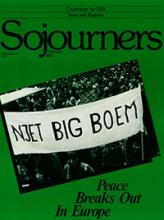"May I infect you with a disease?" Thousands of Londoners have recently received postcards with this alarming proposal from their Dutch neighbors across the North Sea. Instead of wooden shoes and windmills, the picture side of the card depicts a mushroom cloud rising over the word "Europe."
The curious disease being so actively transmitted is "Hollanditis." It was first identified by a distressed American journalist who suspected the Dutch origins of a European epidemic whose symptoms have become increasingly familiar: anxiety in the presence of nuclear weapons, exhaustion with decades of futile negotiations to ban such weapons, distress at the prospect of a nuclear war that would devastate all of Europe, and a massive surge of resistance against such a possibility.
Without a doubt, Hollanditis is a highly contagious malady of conscience. Millions of Europeans have been stricken, and the number of victims is growing rapidly. Sufferers find their lives have been changed as they commit themselves to the elimination of nuclear weapons, starting in their own countries. In the process, they are becoming a powerful political force.
American observers, seeking to explain the outbreak in NATO's share of Europe, claim we are witnessing a resurgence of that insidious strain known as isolationism. More careful observation yields different conclusions, however. In fact, Hollanditis is not a disease of avoidance and escape but of challenge and engagement. Far from being a terminal illness, it is an outbreak of healing which seeks the mending of relationships and the easing of borders. It rejects preparations for a war which might be the world's last, and certainly would be Europe's last. As a bitter joke puts it, "Those Americans and Russians are more courageous and resolute than ever--they are ready to fight to the last European."
A decision for first-strike weaponry
Read the Full Article

